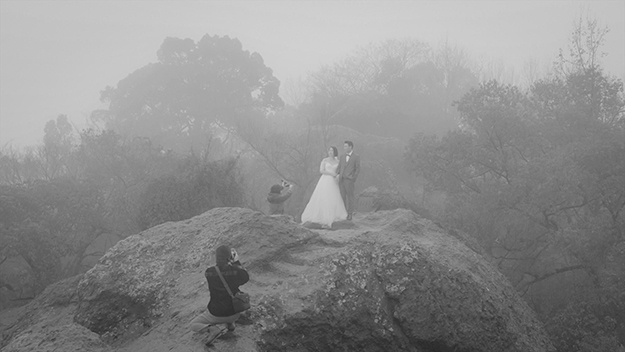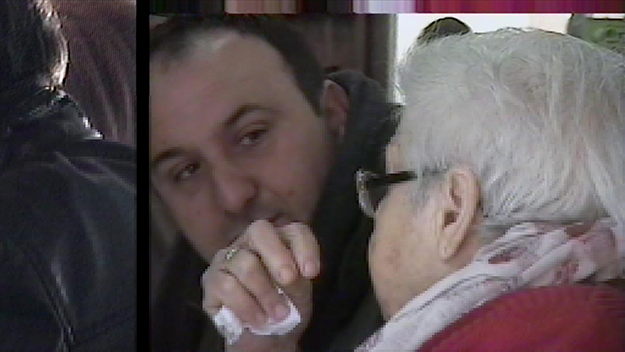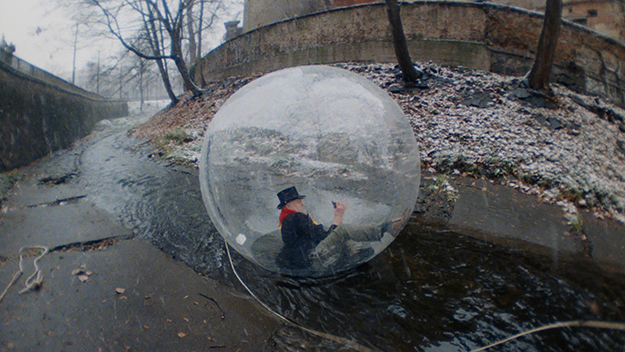Dispatch: Rotterdam 2020

The Cloud in Her Room (Zheng Lu Xinyuan, 2020)
For his final year as director of the International Film Festival Rotterdam, director Bero Beyer put together arguably the strongest Tiger competition of his five-year tenure. Of the ten features comprising the 2020 lineup, only two lacked much in the way of merit, while the others in most cases announced or confirmed the talents of a new crop of young filmmakers. The section’s main awards went to two East Asian debuts: Zheng Lu Xinyuan’s The Cloud in Her Room, winner of the Tiger Award top prize, and Kim Yong-hoon’s Beasts Clawing at Straws, recipient of a Special Jury Award. While completely different in style and temperament—the former being a cooly reflexive hybrid narrative shot in high contrast black and white, and the latter a vividly colored comedic crime spectacle—together the films speak to the rich well of diverse voices that continue to come from East Asia, a region Rotterdam has made considerable efforts over the years to spotlight. (Indeed, each of the last three Tiger winners have come from the region, while one of this year’s retrospective programs was dedicated to Hong Kong films.)
If all goes well, Zheng’s first feature should elevate her among notable young Chinese artists. An author and photographer as well as a filmmaker, Zheng based The Cloud in Her Room on her own experiences of returning to her hometown only to realize that the life that she left there has drastically changed. When 22-year-old Mizi (Jin Jing) arrives to her childhood apartment in Hangzhou, she finds it abandoned, her mother and father now divorced and living in separate parts of town. As she reconvenes with friends (including a former lover) and explores old haunts, Mizi documents her trip with her cell phone camera, recording interactions and conversing with people about their lives in a rapidly changing city. Meanwhile, between visits (and drinks) with her emotionally fragile mother (Lui Dan), she reacquaints herself with her father (Ye Hongming) while getting to know his new wife (Liang Cuishan) and their young daughter, who hasn’t been told she has a step sister. Zheng films these episodes in a combination of documentary-like handheld footage and more static compositions that frequently position Mizi in sharp counterpoint to her surroundings. The austere framings and monochrome palette (along with the occasional negative inversion) betray a knowledge of both contemporary image culture and modernist art cinema, but Zheng’s film doesn’t resemble any one filmmaker or trend—impressive considering the familiar settings (bars, clubs, karaoke joints), archetypal characterizations (when not casually smoking, most of the characters are either drunk, despondent, horny, or some combination of the three), and de rigueur docufiction trappings. Using these tropes to her advantage, Zheng has crafted a personal, consistently surprising reflection on family, femininity, and the role of the home in crafting one’s identity.

Beasts Clawing at Straws (Kim Yong-hoon, 2020)
If The Cloud in Her Room subtly repurposes conventions, then Beasts Clawing at Straws positively revels in them. A shamelessly convoluted neo-noir that pits a variety of fly-by-night criminals against each other in a race for an elusive Louis Vuitton bag bursting with cash, Kim’s debut spins its tale of desperation and class conflict with a precision and ironic edge that would make fellow South Korean Bong Joon Ho proud. Set in the northwest town of Pyongtaek and told achronologically, the film alights on a series of characters—a customs official (Jung Woo-sung) trying to pay off the debts of his conspicuously absent girlfriend (Jeon Do-yeon, of Secret Sunshine fame), a naive sauna employee (Bae Seong-woo) looking for an easy score to help take care of his ailing mother, and a bar hostess (Shin Hyun-been) who enlists the help a low-rent Chinese gangster (Jung Man-sik) to kill her abusive husband—who gradually cross paths as the loot jumps from one person’s possession to the next. As the film’s interlocking stories threads gradually snap into place, it’s Jeon’s characters’ place in this landscape of ever-shifting allegiances that becomes key to unraveling the humorously cynical knot at the core of this carefully orchestrated parable. As the dragon-tattooed femme fatale behind much of the film’s violence, she’s cool and composed in the face of escalating tensions and the bumbling machismo that set these characters on a collision course in the first place. With impressive storytelling acumen and stylistic brio to spare, Kim spins an amoral tale of greed and retribution from the ground up, reminding of the pure visceral pleasures a well-wrought genre exercise can still provide.
If the backdrops of these two films are familiar enough, others in the Tiger Competition took the viewer further afield. In La Fortaleza, Jorge Thielen Armand’s followup to his promising first feature La Soledad (2016), for example, the director casts his own father in a solemn tale of exile and redemption set in the jungles of Southern Venezuela, while in the beautifully photographed, nearly wordless Piedra Sola, first time director Alejandro Telemaco Tarraf depicts a region of Argentina—namely the Puna grasslands of the country’s northern highlands—rarely seen on screen. Equally uncommon, at least to western eyes, is the southernmost Indian state of Tamil Nadu, a region with a rather robust local film industry (comparable in size, if not visibility, to Bollywood) specializing in grandiose dramas, epic policiers, and broad comedies. (In 2018, Rotterdam dedicated an entire program to these ambitious genre exports.) Arun Karthick’s second feature, Nasir, is something different: intimate, poetic, yet baldly political, it’s several degrees quieter and more discreet in its storytelling than most of what’s come from the region. (Or at least what makes its way to festivals.) Centered on the forty-something title character (Koumarane Valavan), a Muslim family man living in Coimbatore, where Hindu nationalism has escalated into extreme forms of intolerance in recent years, the film depicts a society on the brink of violence, where loudspeakers dispense propaganda and soft displays of cultural aggression are the norm. Nasir, for his part, quietly perseveres, working as a fabric salesman and tending to his mentally challenged son while his wife (Sudha Ragunathan) is away visiting relatives. Told over just a handful of days, the film subtly builds tension as Nasir considers a job offer that would take his family to Abu Dhabi, and away from the nascent hostilities that Karthick, by the end, suggests may be impossible for even the gentlest among us to outrun.

The Year of Discovery (Luis López Carrasco, 2020)
The strength of these works notwithstanding, the competition’s two best and most adventurous films were Luis López Carrasco’s The Year of Discovery and Maria Clara Escobar’s Desterro. In Escobar’s first fiction feature, the Brazilian filmmaker tells the story of an unmarried couple and their five-year old son from multiple angles. In the film’s first section, Laura and Israël (Carla Kinzo and Otto Jr.) are seen going about their daily domestic routine, occasionally conversing over breakfast but reserving most of their enthusiasm for their young son, Lucas. They’ve grown apart, but appear resigned to the life they’ve chosen. When Laura, who seems to sense a looming disaster, dies in an offscreen accident while visiting Argentina, the narrative shifts to Israël’s efforts to recover her body while shielding the news from their friends and family. Escobar pivots elliptically between these episodes, offering information in a piecemeal manner—and, even then, usually via gestures and body language more so than exposition. Her visual style situates characters in off-kilter compositions, often at either end of the frame or at a disorienting remove. As in the films of Lucrecia Martel, objects, bodies, and sensory details take precedence over conventional dramaturgy. From there, the story circles back to Laura’s fateful bus trip south to Argentina, where she interacts with a variety of women. Framed in close-up and presented as a series of monologues, these encounters (which lend a hint of documentary realism to the proceedings) reorient the film around the guilt, fears, and responsibilities that society foists upon women and mothers from all walks of life. Almost imperceptibly, Escobar expands Laura’s unspoken but deeply felt struggle into a comment on the patriarchal structures that favor obligation over independence, and which continue to threaten women in unique, often tragic, ways.
In The Year of Discovery, Carrasco looks back on 1992, a watershed year in which Spain, on the 500th anniversary of the discovery of America, hosted both the Olympic Games in Barcelona and the Expo in Seville. But amidst the celebration, turmoil raged as thousands of workers protested against the threatened elimination of various local industries, culminating with the razing of the parliament building in Cartagena. In an effort to revive this all but forgotten moment in Spanish history, Carrasco has recreated the era by staging a documentary in a real-life bar in Cartagena, one where many locals presumably spent a great deal of time discussing and debating these issues nearly three decades ago. Shot on period-appropriate Hi8 video and cast with a variety of non-actors, the film confines itself largely to this single setting, cutting between passages of archival footage and dozens of conversations as people eat, drink, and commiserate with other patrons. For large portions of the film’s 200 minute runtime, these conversations (variously scripted by Carrasco and co-writer Raul Liarte and drawn from interviews with civilians who experienced the events first hand) are presented in split-screen, alternating perspectives within a single discussion or observing the odd detail while the conversation continues in the opposite frame. While an impressive evocation of the period, it soon becomes clear that Carrasco isn’t looking to recreate the past so much as draw a line between then and now. As characters begin to drop modern day details into their stories (such as an offhand mention of the Euro, which Spain only adopted in 2002), we realize that many of the younger participants are referring not to the labor disputes of 1992, but the recession that dilapidated the country’s economy in 2008. As he did in his previous feature El Futuro (2013), in which a group of young people in 1982 throw a house party in celebration of the Socialist party’s victory in the general election, Carrasco nimbly navigates various temporalities without losing sight of the people at the heart of such struggles. No mere stylistic flex, The Year of Discovery is a vital example of cinema’s capacity to rescue memory from the clutches of history.

Communism and the Net or the End of Representative Democracy (Karel Vachek, 2020)
As The Year of Discovery portended, this was the year of the long film at Rotterdam. Indeed, no less than four other films eclipsed the 180 minute mark. Three of these were featured in a section called The Tyger Burns, a program focused on “the gaze of the old filmmaker”—artists who, despite their age and the general neglect of their late-in-life work, show no signs of slowing down. Case in point: Karel Vachek, veritable star of his own 335 minute essay film Communism and the Net or the End of Representative Democracy, in which the once suppressed Czech director, comically large tobacco pipe in hand, takes the viewer on a guided tour through the Czech Republic’s fraught development and into a future of direct democracy enabled and sustained by the internet. In Reiwa Uprising, Japanese documentarian Kazuo Hara (The Emperor’s Naked Army Marches On) likewise concerns himself with his country’s sociopolitical evolution. An on-the-ground look at the recent grassroots campaign to elect trans woman and professor of economics Yasutomi Ayumi to the House of Councillors as a member of the left-wing people’s party Reiwa Shinsengumi, Hara’s four-hour opus bears witness to the power of community, technology, and humanity in changing people’s hearts and minds when up against a largely intolerant system. Far less classifiable, the work of Japan’s Nobuhiko Ōbayashi has been rewiring viewers’ synapses for over four decades. Still primarily known for his horror comedy debut House (1977), Ōbayashi, with over 40 credits to his name, has in fact never waned in productivity, not even when diagnosed three years ago with terminal lung cancer. Centered on a group of young people whose night at the movies finds them transported to a variety of fraught moments in Japanese history, his latest, Labyrinth of Cinema, is a dizzying and improbably touching three-hour trip through the past that plays at once as a summation of the director’s many varied interests and a tribute to the medium that’s sustained him.
At 82 years-old, Ōbayashi was the among the oldest filmmakers in this year’s selection. At 29, Erik Negro was one of the youngest. Non c’è nessuna Dark Side (atto uno 2007–2019), the Italian critic and programmer’s 218 minute debut, is a gauntlet thrown in defense of a truly free cinema. Shot on a variety of formats (Super 8, 16mm, and Mini DV, among them) over the course of 12 years, it might best be described as a diary film, filled as it is with everyday footage captured as Negro came of age as a cinephile, living in the Italian provinces while traveling to various European film festivals—including Rotterdam, which makes a cameo. Flowing unencumbered between moments of serenity and frenetic montages of friends and family, landscapes and natural wonders, the film takes shape as a kind of document of its own making (much of the voiceover and on-camera conversations reflect on the project and its inscrutable, open-ended conception). Accompanying the imagery is a selection of music by bands—among others, Godspeed You! Black Emperor, the National, Gastr del Sol, Nick Drake, and Pink Floyd, whose 1973 album inspired the film’s title—the director turned to for comfort as the footage piled up and began to take on a life of its own. Almost uncomfortably earnest, the film unfolds as a kind of living history of Negro’s interests and inspirations (in a strange parallel with Communism and the Net, the director literally lists his influences in the film’s credits). Interpolated throughout are references to Godard, Ingrid Bergman, Wallace and Gromit, Big Black, The Simpsons, Taxi Driver, Walt Whitman, Dawson’s Creek, and, most prominently, Jonas Mekas, whose sprawling diary films are perhaps the film’s closest antecedent. By turns exhilarating and exasperating, ingratiating and irritating, it’s a work responsible for both the most beautiful and most banal images I encountered at Rotterdam this year, and a cinematic experience hard to imagine having at any another festival.
Jordan Cronk is a critic and programmer based in Los Angeles. He runs Acropolis Cinema, a screening series for experimental and undistributed films, and is a member of the Los Angeles Film Critics Association.







